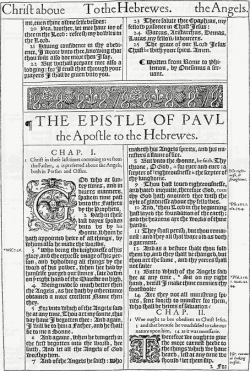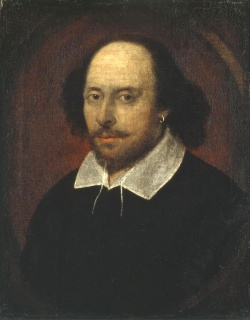Early Modern English
From Textus Receptus
m (Protected "Early Modern English" [edit=autoconfirmed:move=autoconfirmed]) |
Revision as of 02:08, 30 July 2010
Early Modern English (often abbreviated EModE) is the stage of the English language used from about the end of the Middle English period (the latter half of the 15th century) to 1650. Thus, the first edition of the King James Bible and the works of William Shakespeare both belong to the late phase of Early Modern English, although the King James Bible intentionally keeps some archaisms that were not common even when it was published. Prior to and following the accession of James I to the English throne the emerging English standard began to influence the spoken and written Middle Scots of Scotland. Current readers of English are generally able to understand Early Modern English, though occasionally with difficulties arising from grammar changes, changes in the meanings of some words, and spelling differences. The standardisation of English spelling falls within the Early Modern English period and is influenced by conventions predating the Great Vowel Shift, explaining much of the non-phonetic spelling of contemporary Modern English.
Contents |
Pronouns

In Early Modern English, there were two second-person personal pronouns: thou, the informal singular pronoun, and ye, which was both the plural pronoun and the formal singular pronoun (like modern French toi and vous or the German du and Sie). (Thou was already falling out of use in the Early Modern English period, but remained customary for addressing God and certain other solemn occasions, and sometimes for addressing inferiors.) Like other personal pronouns, thou and ye had different forms depending on their grammatical case; specifically, the objective form of thou was thee, its possessive forms were thy and thine, and its reflexive or emphatic form was thyself, while the objective form of ye was you, its possessive forms were your and yours, and its reflexive or emphatic forms were yourself and yourselves.
In other respects, the pronouns were much the same as today. One difference is that, much as a becomes an before a vowel, my and thy became mine and thine before vowels as well; hence, mine eyes, thine uncle, and so on.
| Nominative | Objective | Genitive | Possessive | ||
|---|---|---|---|---|---|
| 1st Person | singular | I | me | my / mine[1] | mine |
| plural | we | us | our | ours | |
| 2nd Person | singular informal | thou | thee | thy / thine[1] | thine |
| plural or formal singular | ye | you | your | yours | |
| 3rd Person | singular | he / she / it | him / her / it | his / her / his (it)[2] | his / hers / his[2] |
| plural | they | them | their | theirs | |
</center>
- 1. The possessive forms were used as genitives before words beginning with a vowel sound and letter h (e.g. thine eyes, mine heire). Otherwise, "my" and "thy" is attributive (my/thy goods) and "mine" and "thine" are predicative (they are mine/thine). Shakespeare pokes fun at this custom with an archaic plural for eyes when the character Bottom says "mine eyen" in A Midsummer Night's Dream.
- 2. From the early Early Modern English period up until the 17th century, his was the possessive of the third person neuter it as well as of the 3rd person masculine he. Genitive "it" appears once in the 1611 King James Bible (Leviticus 25:5) as groweth of it owne accord.

Orthographic conventions
The orthography in Early Modern English was fairly similar to that of today, but spelling was unphonetic and unstable; for example, the word acuity could be spelled either <acuity> or <acuitie>. Further, there were a number of features of spelling that have not been retained:
- The letter <S> had two distinct lowercase forms: <s> as today, and <ſ> (long s). The former was used at the end of a word, and the latter everywhere else, except that double-lowercase-S was variously written <ſſ> or <ſs>.<ref>cite book|last=Burroughs|first=Jeremiah|authorlink=Jeremiah Burroughs|coauthors=Greenhill, William|title=The Saints Happinesse|url=http://books.google.com/books?id=ByU3AAAAMAAJ|year=1660 Introduction uses both happineſs and bleſſedneſs.</ref>
- <u> and <v> were not yet considered two distinct letters, but different forms of the same letter. Typographically, <v> was used at the start of a word and <u> elsewhere<ref>Cite book | author=Sacks, David | authorlink= | coauthors= | title=The Alphabet | date=2004 | publisher=Arrow | location=London | isbn=0-09-943682-5 | page=316</ref>; hence vnmoued (for modern unmoved) and loue (for love).
- <i> and <j> were also not yet considered two distinct letters, but different forms of the same letter, hence "ioy" for "joy" and "iust" for "just".
- A silent <e> was often appended to words. The last consonant sometimes was doubled when adding this <e>; hence ſpeake, cowarde, manne (for man), runne (for run).
- The sound IPA|/ʌ/ was often written <o> (as in son); hence ſommer, plombe (for modern summer, plumb).<ref>W.W. Skeat, in Principles of English Etymology, claims that the o-for-u substitution was encouraged by the ambiguity between u and n; if sunne could just as easily be misread as sunue or suvne, it made sense to write it as sonne. (Skeat, Principles of English Etymology, Second Series. Clarendon Press, 1891. Page 99.)</ref>
Nothing was standard, however. For example, "Julius Caesar" could be spelled "Julius Cæſar", "Ivlivs Cæſar", "Jvlivs Cæſar", or "Iulius Cæſar" and the word "he" could be found being spelled "he" or "hee" in the same sentence in Shakespeare's plays.
Verbs
Verb conjugations in the "thou" form (second person informal singular) end in -(e)st (e.g. "thou takest"). In Early Modern English, third person singular conjugations end in -(e)th instead of -s (e.g. "he taketh"). Both the second person informal singular and third person singular lost their endings in the subjunctive, which uses the bare stem of the verb.
The perfect tenses of the verbs had not yet been standardized as to all use the auxiliary verb "to have". Some took as their auxiliary verb "to be", as in this example from the King James Bible, "But which of you ... will say unto him ... when he is come from the field, Go and sit down..." [Luke XVII:7]. The rules that were followed as to which verbs took which auxiliaries were similar to those still used in German and French.
Vocabulary
Although the language is otherwise very similar to that current, there have in time developed a few "false friends" within the English language itself, rendering difficulty in understanding even the still-prestigious phrasing of the King James Bible. The most glaring is that the passage "Suffer the little children" meant, "Permit..." (this usage of the word "suffer" is still sometimes used in some dialects in formal circumstances).
Development from Middle English
Template:See also The change from Middle English to Early Modern English was not just a matter of vocabulary or pronunciation changing: it was the beginning of a new era in the history of English.
An era of linguistic change in a language with large variations in dialect was replaced by a new era of a more standardized language with a richer lexicon and an established (and lasting) literature. Shakespeare's plays are familiar and comprehensible today, 400 years after they were written, but the works of Geoffrey Chaucer and William Langland, written only 200 years earlier, are considerably more difficult for the average reader.
Timeline
- 1476 – William Caxton starts printing in Westminster, but the language he uses reflects the variety of styles and dialects used by the authors whose work he prints.
- 1485 – Tudor dynasty established; start of period of (relative) political and social stability.
- 1491 or 1492 – Richard Pynson starts printing in London; his style tends to prefer Chancery Standard, the form of English used by government.
- c. 1509 – Pynson becomes the king's official printer.
- From 1525 – Publication of William Tyndale's Bible translation (which was initially banned).
- 1539 – Publication of the Great Bible, the first officially authorised Bible in English, edited by Myles Coverdale, largely from the work of Tyndale. This Bible is read to congregations regularly in churches, familiarising much of the population of England with a standard form of the language.
- 1549 – Publication of the first Book of Common Prayer in English, under the supervision of Thomas Cranmer. This book standardises much of the wording of church services.
- 1557 – Publication of Tottel's Miscellany.
- c. 1590 to c. 1612 – William Shakespeare's plays written; they are still widely read and familiar in the 21st century.
- 1611 – The King James Bible is published, largely based on Tyndale's translation. It remains the standard Bible in the Church of England for many years.
- c. 1640–1660 – Period of social upheaval in England (the English Civil War and the era of Oliver Cromwell).
- 1651 – Publication of Leviathan by Thomas Hobbes.
- 1662 – New edition of the Book of Common Prayer, largely based on the 1549 and subsequent editions. This also long remains a standard work in English.
- 1667 – Publication of Paradise Lost, by John Milton.
Development to Modern English
The 17th century was a time of political and social upheaval in England, particularly the period from about 1640 to 1660. The increase in trade around the world meant that the English port towns (and their forms of speech) would have gained in influence over the old county towns. England experienced a new period of internal peace and relative stability, encouraging the arts including literature, from around the 1690s onwards. Another important episode in the development of the English language started around 1607: the British settlement of America. By 1750 a distinct American dialect of English had developed.
There are still elements of Early Modern English in some dialects. For example, thee and thou can still be heard in the Black Country and some parts of Yorkshire. The pronunciation of book, cook, look, etc. with a long [uː] can be heard in the more remote areas of the North and the West Country. However, these are becoming less frequent with each new generation.
